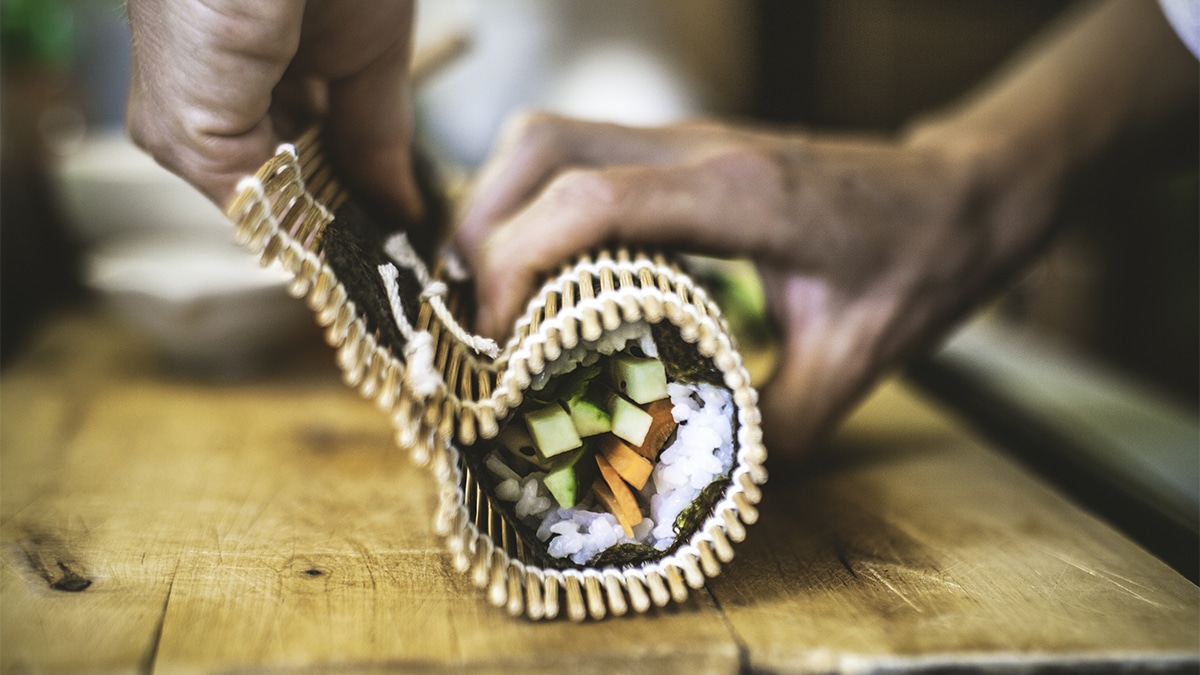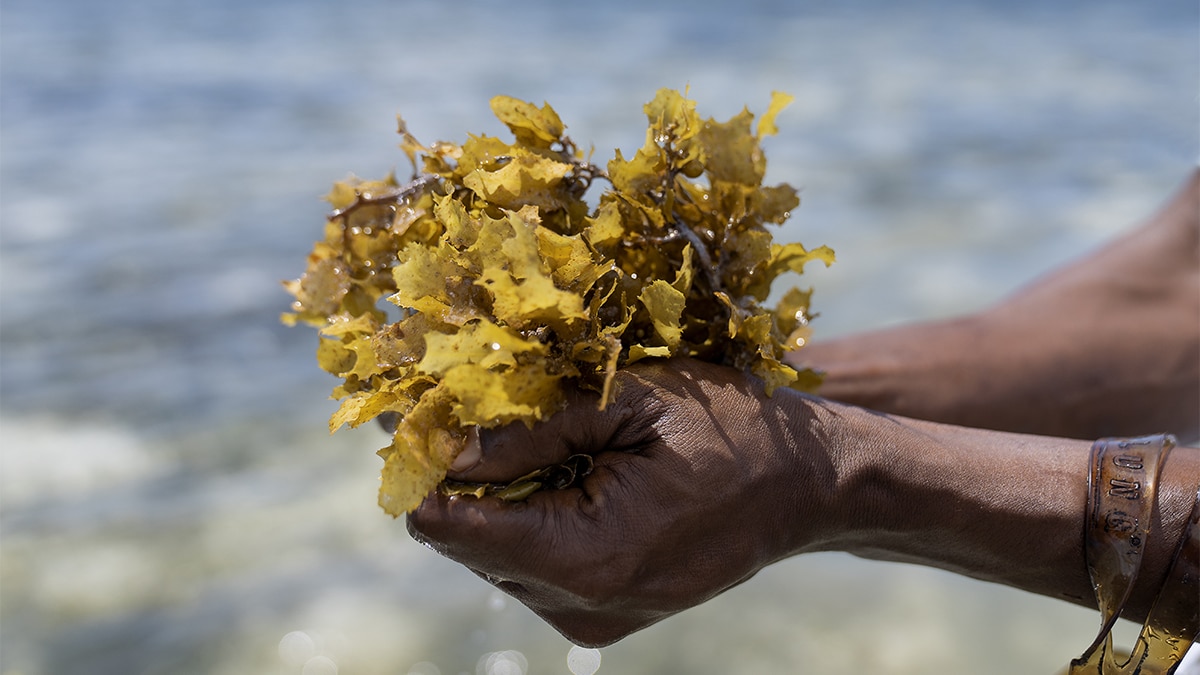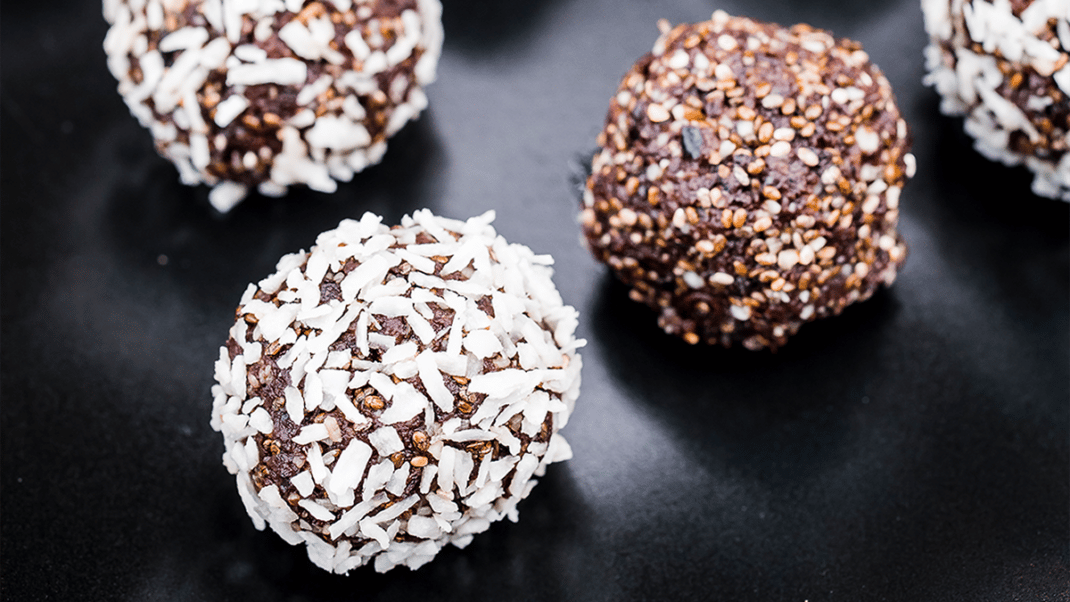Sea Greens: A New Look at an Ancient Staple
Take a deeper dive into seaweeds, sea greens and sea vegetables, including their characteristics, benefits and common uses—along with guidance on how to introduce them while honoring the cultures and peoples that have treasured them for centuries.
| Earn 1 CEC - Take Quiz

Seaweeds, sea greens, sea vegetables—whatever you call them, they’re having a moment in the U.S. The fact is, they’ve long been a staple in the States among the East Asian diaspora, but they’re now being embraced by foodies, the functional-food set and those attuned to sea greens’ environmental and social justice benefits. Get to know this new-old category of nutrient-packed gifts from the sea for yourself and your clients.
But First: A Story and a Gentle Reminder
I sat on the kitchen floor looking up at my grandmother’s hands deftly fanning a thin semitranslucent sheet of dry pressed seaweed—gim—directly over the electric stovetop. She expertly crisped it without charring. She brushed it with oil, sprinkled it with salt, cut it into smaller sheets and passed me a piece before returning to the stack. It was warm and crisp and savory, tasting gently of the sea. I was probably 5 years old, and this was a treat, not an everyday food (despite what you see on today’s grocery shelves, where roasted and salted seaweed is sold as health food).
Gim was a food that would earn strange looks at school. That it’s accepted and embraced as “trendy” today is a fact that carries a double-edge for people like me who endured those “lunchbox looks” as kids. When a food is dubbed “new” or “trendy,” we should be asking ourselves, “According to whom? Who does that positioning center? And who does it otherize?”
From this writer’s perspective, being told seaweed is a “new and exciting” food ripe for “discovery” ignores my lived experience. Honestly, it hurts.
All the same . . . Am I indeed excited that a food I grew up with is being widely accepted? Am I proud of my cultural foods? Do I want the local economies that depend on seaweed to thrive? The answer is yes, yes and yes! See? A double-edge.
All of that said, it would be my pleasure to be your guide to seaweeds. And if they are new to you, welcome!
Mindful exploration. Many articles on sea greens lightly reference their cultural importance. This article instead starts from a place of cultural humility. It fundamentally understands we have something to learn from other cultures. If seaweed is new to you, give yourself permission to explore its rich culinary history. Just be mindful to avoid terms (such as exotic, weird or new) that center yourself and therefore otherize these cultures. And learn how seaweed is enjoyed in various culinary traditions before finding new ways to enjoy it.
See also: Helping Clients Enjoy the Taste and Culture of Food
Getting to Know Sea Greens

Though seaweeds may be a relatively new-to-you food in the United States, seaweeds have been enjoyed for thousands of years.
Sea greens is a new term meant to foster familiarity in the American mind by conjuring a connection to leafy greens (Seaver 2016). For our purposes, we’ll use the terms sea greens and seaweeds interchangeably.
Though seaweeds may be a relatively new-to-you food in the United States, seaweeds have been enjoyed for thousands of years (Tiwari & Troy 2015). In Korea, there is a birthday tradition of enjoying seaweed soup called miyeok guk. In Japan, seaweeds are a staple in miso soup. In Malaysia and Indonesia, seaweed is eaten in salads. In other parts of the world, seaweeds have been used as animal feed (Greece), medicine (Mediterranean region) and mulch for farmland (Ireland and Scotland) (Tiwari & Troy 2015). Today, about 60% of global seaweed is consumed in China, Korea and Japan, followed by increasing consumption in Europe and the Americas (FAO 2018).
An Overview
Fun fact: Technically, seaweeds aren’t plants, they’re macro-algae (large algae). Instead of roots, they have holdfasts. Instead of stems, they have stipes. And instead of leaves, they have blades. They also don’t need a vascular system to transport nutrients: They absorb them directly from the water. However, just like plants, seaweeds photosynthesize, turning sunlight, carbon dioxide and water into oxygen and energy. But if you still want to think of them as plants, they won’t mind.
There are thousands of species of seaweed, 700 of which have been documented, and humans across 43 countries have found ways to use 291 of those species (Cai et al. 2021; Tiwari & Troy 2015).
Sea greens are categorized as red, brown or green. The most common culinary sea greens you’re likely to come across in the U.S. today are a red seaweed called laver and two brown seaweeds called sea mustard and kelp. Here are some insights into their origins and uses, along with other popular species in each of these color categories.
Red Sea Greens
Red sea greens are the most commonly cultivated seaweeds around the world (Tiwari & Troy 2015). They are generally small, ranging from an inch to a few feet in length.
Laver. Sometimes called purple laver or gim, this seaweed turns a dark green when dried. It is roasted and pressed into sheets in much the same way paper is made. It’s used for rice rolls and snacking (as mentioned earlier), as a garnish, and in Welsh laverbread. It has been consumed for centuries in East Asia, northwest America, Canada, Hawaii, New Zealand, Wales, Ireland and Scotland (Tiwari & Troy 2015). (See “Learn Your Client’s Food Language,” below, for the various common names of this and other seaweeds.)
Dulse. A ruddy seaweed with a soft leathery texture, dulse is harvested in Ireland, eastern Canada and Maine. It’s often sold as a seasoning in flaked, shredded or powdered form. It can be sprinkled on chips, baked into bread (such as Irish soda bread), added to fish stews, or cooked and used as a bacon substitute (Tiwari & Troy 2015).
Carrageen moss. Resembling small trees, this seaweed is native to the Atlantic coasts of Europe and the United States. It has a long history of use in Ireland as a thickener for puddings and soups, and it has been part of traditional medicine for more than a thousand years (FAO 2018). It’s also used in salads and is sometimes called Irish moss, not to be confused with sea moss, which is a sea green used to make another thickener called agar-agar (Tiwari & Troy 2015).
Brown Sea Greens
Brown seaweeds are the second most commonly cultivated seaweed and are usually large, growing up to 100 feet or more. Other types are 10–20 inches or 5–10 feet. Most brown sea greens have a low fat content—around 1.5%—but, of that, 20%–25% is the anti-inflammatory EPA omega-3 fatty acid (FAO 2022; Tiwari & Troy 2015).
Kelp. This large sea green naturally contains abundant glutamates, one of the magic compounds behind the savory flavor known as umami. Smaller amounts of glutamates are found in other sea greens. Dried kelp is commonly used to add depth to soup bases, fried in oil for a thick chip and sliced into strips as noodles. It is often dried, but it can also be found in fermented (jarred), fresh and frozen forms.
Sea mustard. A smaller kelp, sea mustard offers a mild taste and silky-smooth texture. Dried sea mustard rehydrates in minutes for salads or can be added directly to soups. It will expand, so a little goes a long way. It is cultivated in Japan, South Korea, China, France, New Zealand and Australia (Tiwari & Troy 2015).
Arame. This mild sea green is rich in a bioavailable form of calcium. Arame is packaged and sold after being sun-dried, steamed or boiled for hours, then dried again. It rehydrates in a few minutes, but be careful not to oversoak it or it will lose its flavor. It works well in salads (Tiwari & Troy 2015).
Hizikia. Thin and branched, hizikia is used like a vegetable in meals. Like arame, it is sun-dried then boiled (to remove arsenic), then dried again. It’s black once it’s been processed. Due to its arsenic content, many countries warn against eating large quantities. It is also called hijiki, hiziki and tot. It grows in China, Korea and Japan (Tiwari & Troy 2015). See “Seaweed Safety,” below, for more information.
Green Sea Greens
Green seaweeds are less commonly found in supermarkets, but you may come across sea lettuce and sea grapes. They are similar in size to red seaweeds (FAO 2022).
Sea lettuce. Usually collected wild in Japan, this seaweed looks like a head of green lettuce, and it’s often eaten in salads (Tiwari & Troy 2015).
Sea grapes. Not surprisingly, this species looks like miniature elongated clusters of tiny green grapes. They burst when you bite into them, similar to the way caviar does, releasing a salty ocean flavor. Sea grapes, which are cultivated in the Philippines, are very perishable, so they are sold in dried form (Tiwari & Troy 2015).
Recap. Sea greens are a culinary secret weapon. They are typically sold dry, making them an easy dietary staple, whether stored in the pantry or double-bagged and tucked in the freezer, and they rehydrate easily for easy everyday use. Sea greens also contain amino acids called glutamates that offer up the savory taste sensation known as umami. Using a little adds depth without an overpowering seaweed flavor.
Health Benefits of Sea Greens

Be cautious about fully accepting or rejecting certain seaweeds, but have comfort that seaweeds have been enjoyed safely as part of traditional diets for millennia.
Sea greens provide proteins, healthy fats, prebiotic fiber, vitamins, minerals and trace minerals. Notably, seaweeds provide important nutrients for vegans and vegetarians: vitamin B12, calcium, iodine and omega-3 fatty acids. They also offer bioactive compounds with antimicrobial, antioxidant, anti-inflammatory, anti-cancer and anti-diabetic activities (Tiwari & Troy 2015).
Populations in East Asia following heritage diets marked by regular seaweed intake tend to be healthier and less burdened by several chronic diet-related diseases (Brown et al. 2014). In Korea, Japan and parts of China, this amounts to 5–8 grams per day of dried seaweed.
Nutrients
Nutrients in three of the most commonly used sea greens follow (Tiwari & Troy 2015). Note that nutrients differ by species, season and location.
Laver is usually about 30%–50% protein with a decent 75% digestibility. It provides vitamins A (10 times as much as spinach), B1, B2, B3 (niacin), B6, B9 (folic acid), B12 and C (though vitamin C will diminish with drying).
Sea mustard is higher in fiber than laver. While low in total fat, it does offer omega-3 fatty acids. Air-drying preserves its B vitamins, but processing (including cooking) depletes them.
Kelp is about 10% protein with three times the iron found in laver, half its B1, and a tenth of its B2, B3 and B12. It also provides iodine, an essential micronutrient for healthy thyroid function.
Early Research
While traditional wisdom may show benefits, modern research is limited. Most studies are animal or cell studies, with a handful of human studies and mixed results. When studies show different results, it’s confusing to interpret them for clients. It’s important to remember that we should guide clients based on the totality of the evidence, including a consideration for its quality.
In nutrition research, there are pebbles and there are boulders; sometimes enough pebbles build up to make a decent rock. We have many pebbles of seaweed research today. Until they add up to a boulder, be cautious about fully accepting or rejecting certain seaweeds, but have comfort that seaweeds have been enjoyed safely as part of traditional diets for millennia. (See “Seaweed Safety,” below, for information on special considerations.)
Here are some of the early research findings from Brown et al. (2014) that may be of interest to you and your clients, depending on their specific health challenges and goals.
Heart health. Seaweed, along with soy and fish, is part of the Okinawa diet—a famous longevity diet that originated in Japan. Observational data suggests seaweed protects against heart disease, and small studies found seaweed can lower cholesterol and blood pressure.
Metabolic syndrome. In a study based on the Nutrition and Health Survey in Taiwan, seaweed was one of a group of foods linked to protection against metabolic syndrome in women. Consuming 4–6 g of dried sea mustard per day lowered blood pressure and reduced waist size in a small study in Ecuador.
Weight management. In one small study, eating a seaweed-enriched bread at breakfast led to people eating a smaller lunch 4 hours later, perhaps due to the seaweed’s fiber content. At the end of the day, participants had eaten about 500 fewer calories. When that same seaweed fiber was delivered in a pill, however, there was no effect.
Type 2 diabetes. A study in Korean males found that a single dose of brown seaweed extract improved insulin sensitivity after a carbohydrate-rich meal, though it did not improve postmeal glucose. After 4 weeks of use, fiber-rich kelp and sea mustard supplements lowered blood glucose in 20 participants with diabetes.
Gut health. Animal studies show that seaweed fibers are prebiotics shown to increase production of anti-inflammatory short-chain fatty acids, and they can protect good gut bacteria, as well.
Bone health. Some seaweeds provide significant amounts of calcium, an important mineral for bone health. In some studies, eating seaweed has improved bone mineral density, joint mobility and pain, which are markers of osteoporosis.
Cancer. The theory is that since cancer rates are lower in countries that eat a lot of seaweed, there may be a protective effect. Animal and cell studies show seaweed has anti-cancer activities, but larger human studies are needed.
Health takeaways. Observational data suggests populations with a tradition of regularly eating seaweed are living longer and with less disease. Early studies hint that bioactives in seaweeds promote a wide range of health benefits, but most of the evidence to date is in animal and cell studies. More studies in humans are needed to confirm clinical benefits. In the meantime, seaweeds offer many beneficial nutrients.
See also: Health Lessons From the World’s Blue Zones
Seaweed Safety
As a general guide, 5–8 g of dried seaweed or 30–50 g of wet seaweed has been safely consumed in East Asian cuisines on a regular everyday basis (Tiwari & Troy 2015). Still, here are a few safety notes to keep in mind:
Iodine. This is an essential trace mineral that tends to be low in vegans, but too much can trigger either hypothyroidism or hyperthyroidism, depending on the person. Large kelp has the most iodine, but boiling reduces the amount (Cherry et al. 2019). Clients also should consult their healthcare team about its culinary use.
Heavy metals. Seaweeds can soak up heavy metals, so seaweed destined for human or animal foods should be tested for metals. France sets upper limits, and one study found seaweed samples from Spain were over France’s limit for cadmium and inorganic arsenic (the toxic form). On the other hand, a different study found seaweeds from South Korea were safe for consumers (Cherry et al. 2019).
Arsenic can be toxic (inorganic arsenic), nontoxic (arsenobetaine) or possibly toxic (fat-soluble arsenic, arsenosugars and other organoarsenicals). Inorganic arsenic damages DNA and increases the risk of cancers.
Most arsenic in seaweeds are arsenosugars. Across brown, red and green seaweeds studied, the total arsenic in the seaweed contained less than 1 microgram per g of seaweed.
Kelp tends to be higher in arsenic, but arame, sea mustard, kelp and laver are considered safe to eat. Note that cooking increased arsenic in laver, but in other seaweeds, it was reduced by soaking (-58.8%), cooking (-91.5%), boiling (-50%), and washing and soaking (-60%) (Cherry et al. 2019).
Safety overview. Kelp is considered safe to eat, but it is relatively higher in iodine and arsenic. Levels of both can be reduced by cooking. Expectant mothers should consult their physician regarding consumption of sea greens. Seaweed supplements are not recommended for pregnant women since iodine content in them is variable.
See also: Understanding Food Allergy, Intolerance and Sensitivity
Sea Greens and a Healthy Planet
If we continue to produce and consume food the way we do today, we’ll soon need two planet Earths to sustain us (Tiwari & Troy 2015). Seaweed farming offers part of the solution by growing massive amounts of nutrient-rich food without using any fresh water, chemical fertilizer or land—they need only ocean and sun to thrive. Seaweeds are quick-growing crops that trap up to 20 times more carbon per acre than land forests, and they help fight ocean acidification (Hurlimann 2019).
Most (96%) of what humans use is produced through aquaculture, or water cultivation (Tiwari & Troy 2015). Aquaculture adds oxygen to the waters for other sea life to use, and the seaweed being grown soaks up excess nutrients (e.g., nitrogen and phosphorus). This is helpful because too much nitrogen and phosphorus can lead to algal bloom, or a too-rapid growth of algae in water, which depletes ocean oxygen (NOAA Fisheries 2020). Farming seaweeds has also been shown to improve biodiversity in coastal waters.
Because seaweeds act like sponges, cleaning up the water around them, they can also be cultivated to soak up heavy metals and pollution. This kind of seaweed would not be used for food, however (NOAA Fisheries 2020).
Summary. Sea greens are a regenerative crop that uses little to no resources, absorbs excess carbon and keeps oceans healthy.
Sea Greens and the Blue Economy

Sea greens cultivation is the fastest growing sector in U.S. aquaculture.
Sea greens are part of the blue economy, which includes the sale of blue foods, or foods derived from freshwater and ocean sources. Three billion people count on blue foods for vital nourishment, and 800 million people depend on them to make a living, with nearly half of that workforce being women (BFA 2022).
Sea greens cultivation is the fastest growing sector in U.S. aquaculture (NOAA Fisheries 2022). The costs to enter the industry are relatively low, and investment offers quick returns: The first crop can be ready in 6 weeks (FAO 2018). Aquafarming areas exist where the ocean meets the land, which makes them safe to access. Some studies have noted women are more patient and willing to learn about sustainably managing seaweed harvests.
For all these reasons, there is a global trend of women taking advantage of opportunities in the seaweed economy. As the saying goes, a rising tide lifts all boats, and these economic opportunities have allowed women to pay for food and medical expenses and, by proxy, children to access education (FAO 2018).
Economic overview. Low barriers to entry mean seaweed cultivation offers feasible economic opportunities to developing coastal areas, and it specifically improves gender parity by creating economic opportunities for women. Social “safety net” benefits extend to the community, including children.
Join the Seaweed Revolution!
Sea greens are healthy for humans, sustainable for the planet and a force for social good in the communities that cultivate them. Further, sea greens are delicious, exciting cultural foods, and they are easy to store and prepare. It’s important to be aware of risks so that they can be mitigated. Namely, sea greens can be a regular food, but at moderate levels of about 5 g per day (of dried products). Expectant mothers should consult with their healthcare team. The seaweed revolution is upon us, and health and wellness experts are poised to help clients understand their potential.
Learn Your Client’s Food Language
Just as apples in America are called pommes in France, sea greens are known by different names in the various cultures that have long enjoyed them. When working with clients from diverse cultures, it’s helpful to “speak their language” when it comes to sea greens. It improves rapport, and the specificity is a sign of respect through acknowledgment. This is not a complete list, but it offers a primer on the three most commonly consumed sea greens.
Source: Kavanagh 2021.
A Few Words About Microalgae
Seaweeds refer to macroalgae. Spirulina and chlorella are blue-green and green microalgae, respectively, that are used as functional ingredients. Production of microalgae is small compared to that of seaweeds, and they are typically cultivated on land, so they don’t come with the same natural-resource–saving benefits as seaweeds (Cai et al. 2021). For that reason, the focus of this article is on the most common macroalgae options.
Sea Greens: Not “New” but “Growing”
The world production of seaweed tripled in 15 years from the late ’90s to early 2010s (Tiwari & Troy 2015). The global market is set to be worth $85 billion by 2026 (GM Insights 2020). Meanwhile, more than half of Americans are choosing plant-based foods for health benefits (NielsenIQ 2021), including plant-based seafood (many include seaweeds as key ingredients), whose sales grew 23% in 2020 (GFI 2020). Add to the mix that 85% of people are shifting their dollars to more sustainable options (Business Wire 2021). All of these factors contribute to the rising interest in sea greens in the U.S.
Keep Learning Online
Visit these websites for more information on the cultivation and cooking of sea greens.
- The Blue Food Assessment Initiative (BlueFood.earth)
- Aquatic Food Composition Database (Dataverse.Harvard.edu)
- Center for Ocean Solutions (OceanSolutions.Stanford.edu)
- Seaweed recipes (Maangchi.com)
References
BFA (The Blue Food Assessment). 2022. Why is it important? Accessed May 19, 2022: bluefood.earth/.
Brown, E.M., et al. 2014. Seaweed and human health. Nutrition Reviews, 72 (3), 205–16.
Business Wire. 2021. Recent study reveals more than a third of global consumers are willing to pay more for sustainability as demand grows for environmentally-friendly alternatives. Accessed May 19, 2022: businesswire.com/news/home/20211014005090/en/Recent-Study-Reveals-More-Than-a-Third-of-Global-Consumers-Are-Willing-to-Pay-More-for-Sustainability-as-Demand-Grows-for-Environmentally-Friendly-Alternatives.
Cai, J., et al. 2021. Seaweeds and microalgae: An overview for unlocking their potential in global aquaculture development (Rome, Italy). FAO Fisheries and Aquaculture Circular, 1229. doi.org/10.4060/cb5670en.
Cherry, P., et al. 2019. Risks and benefits of consuming edible seaweeds. Nutrition Reviews, 77 (5), 307–29.
FAO (Food and Agriculture Organization of the United Nations). 2018. The global status of seaweed production, trade and utilization (Rome, Italy). Globefish Research Programme, 124, 1–120.
FAO. 2022. Introduction to commercial seaweeds. Accessed May 19, 2022: fao.org/3/y4765e/y4765e04.htm.
GFI (Good Food Institute). 2020. 2020 U.S. retail market data for the plant-based industry: Plant-based seafood remains a white space. Accessed May 19, 2022: gfi.org/marketresearch/.
GM Insights (Global Market Insights, Inc.). 2020. Commercial seaweed market to hit $85 billion by 2026, says Global Market Insights, Inc. Accessed May 19, 2022: globenewswire.com/en/news-release/2020/07/15/2062348/0/en/Commercial-Seaweed-Market-to-hit-85-billion-by-2026-Says-Global-Market-Insights-Inc.html.
Hurlimann, S. 2019. How kelp naturally combats global climate change. Harvard University: The Graduate School of Arts and Sciences. Accessed May 19, 2022: sitn.hms.harvard.edu/flash/2019/how-kelp-naturally-combats-global-climate-change/.
Kavanagh, U-M. 2021. 10 great Irish words for seaweed. Accessed May 20, 2022: https://weareirish.ie/gaeilge/10-great-irish-words-for-seaweed/.
NielsenIQ. 2021. Analysis: Growing demand for plant-based proteins. Accessed May 19, 2022: nielseniq.com/global/en/insights/analysis/2021/examining-shopper-trends-in-plant-based-proteins-accelerating-growth-across-mainstream-channels/.
NOAA Fisheries. 2020. Seaweed aquaculture: Seaweed farming, the fastest-growing aquaculture sector, can benefit farmers, communities, and the environment. Accessed May 19, 2022: fisheries.noaa.gov/national/aquaculture/seaweed-aquaculture.
Seaver, B. 2016. Superfood Seagreens: A Guide to Cooking with Power-Packed Seaweed. New York: Sterling.
Tiwari, B.K., & Troy, D.J. 2015. Seaweed Sustainability: Food and Non-Food Applications. San Diego: Academic Press (Elsevier).
Maggie Moon, MS, RD
Maggie Moon, MS, RD, is the best-selling author of The MIND Diet, and lead author of the "Medical Nutrition Therapy for Neurologic Disorders" chapter in Krause and Mahan’s Food and the Nutrition Care Process (15th ed). She completed her clinical training at New York Presbyterian Hospital of Columbia and Cornell, and holds a master of science degree in Nutrition and Education from Columbia University’s Teachers College, with a bachelor of arts degree in English Literature from U.C. Berkeley. Her culinary school training is from The New School of Cooking in Los Angeles.






